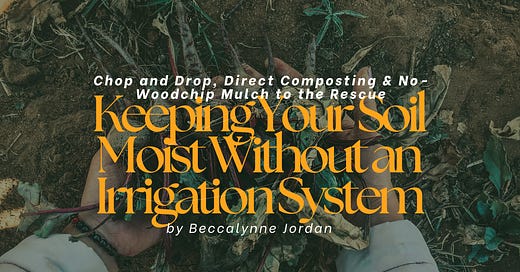Keeping Your Soil Moist Without an Irrigation System and Using What You Already Have
Chop and Drop, Direct Composting & No-Woodchip Mulch to the Rescue
Every summer, I get messages that go something like this:
"I can’t afford an irrigation system. My soil dries out in hours. What can I do without spending more money?"
And honestly, I get it. I’ve been there—dragging hoses, making mental deals with the weather, and watching my garden wilt faster than I can carry a watering can. But over the years, I’ve learned something game-changing: if you keep your soil covered and fed, it’ll hold onto water like it wants to stay moist. And you don’t need anything fancy to make that happen.
Here’s how I do it, using what I already have in the garden.
Chopping and Dropping: The Low Effort Gardener’s Blanket
You don’t need to buy mulch when your plants are already growing it for you.
When your herbs bolt, your comfrey flops, or your tomatoes get wild—chop them and drop them right where they are.
This method mimics nature: plants grow, die, and cover the soil. Simple.
The roots stay in place (feeding the soil organisms), and the leaves become a light, living mulch. As it breaks down, it not only holds moisture but also feeds the soil. It’s like tucking your garden in with a cozy duvet made from itself.
What I love most about chop and drop is that it’s zero effort after the chop. No hauling. No bagging. No trips to the store. Just snip, drop, and walk away.
Best plants for chop and drop:
Comfrey
Borage
Mint
Calendula
Yarrow
Spent brassica leaves
Rhubarb leaves
Any leafy green you’re not eating anymore
Direct Composting: Feed the Soil From Within
Instead of building a compost pile or buying compost, I compost straight into the garden. This means digging a small hole or trench, tossing in kitchen scraps, and covering it with soil or mulch. That’s it.
What does this have to do with moisture? A lot.
As scraps break down in the soil, they act like tiny sponges, soaking up water and slowly releasing it. Plus, the decomposing matter improves soil texture and microbial life, which helps your soil hold onto moisture even better.
Pro tip: I often layer garden scraps (like pulled weeds or bolted lettuce) with kitchen bits in the same hole. It’s messy. It’s magical.
Mulching Without Woodchips: Get Creative
Woodchips can be expensive, hard to find, or simply not your vibe. The good news is, there are plenty of other ways to mulch:
Weeds: Yes, really. Pulled weeds (as long as they’re not going to seed) make fantastic mulch. Just layer them around your plants, roots up.
Straw or dried grass clippings: Free, lightweight, and easy to spread.
Leaf litter: If you’re lucky enough to have deciduous trees nearby, dried leaves make a beautiful, natural mulch.
Spent plants: Don’t pull those dead bean vines or dried calendula stalks—snip them at the base and lay them on the soil.
Cardboard: Especially good for paths or around perennials. Weigh it down with garden scraps and it’ll slowly break down.
What all these materials have in common is that they shield the soil from the sun, wind, and evaporation. Covered soil stays cool. Bare soil bakes.
Why Covered Soil Holds Water Better
Imagine standing in the sun versus standing under a shady tree. That’s the difference between bare soil and covered soil.
When we cover the soil:
Moisture stays in the ground longer
Soil temperatures stay stable
Microbes thrive
We water way less
And here’s the kicker: you don’t need to spend money or buy anything to do this. Your garden is already producing everything it needs to keep itself covered and hydrated.
In My Garden This Week…
I chopped back a bolted cilantro patch and used it to mulch my peppers. I buried banana peels and coffee grounds near the squash. I covered a bare patch of soil with pulled dandelions, root side up. It’s not glamorous, but when I dig down a few inches, it’s moist and cool—even after days without rain.
So if your soil is drying out too fast, look around before you buy. The solutions are probably already growing right in your garden.
Have you tried any of these low-effort, no-cost moisture tricks in your own garden? Let me know what’s working—or what’s drying out! Let’s chat about it.
Beccalynne.




Even though for years I've been burying kitchen scraps, chopping and dropping, and mulching with grass clippings and pine straw, every time I do them now, I think of you 😂. With the clay soil, these practices have allowed me to grow abundantly every year. Keep teaching this!
This is so helpful and practical! Thank you for sharing.